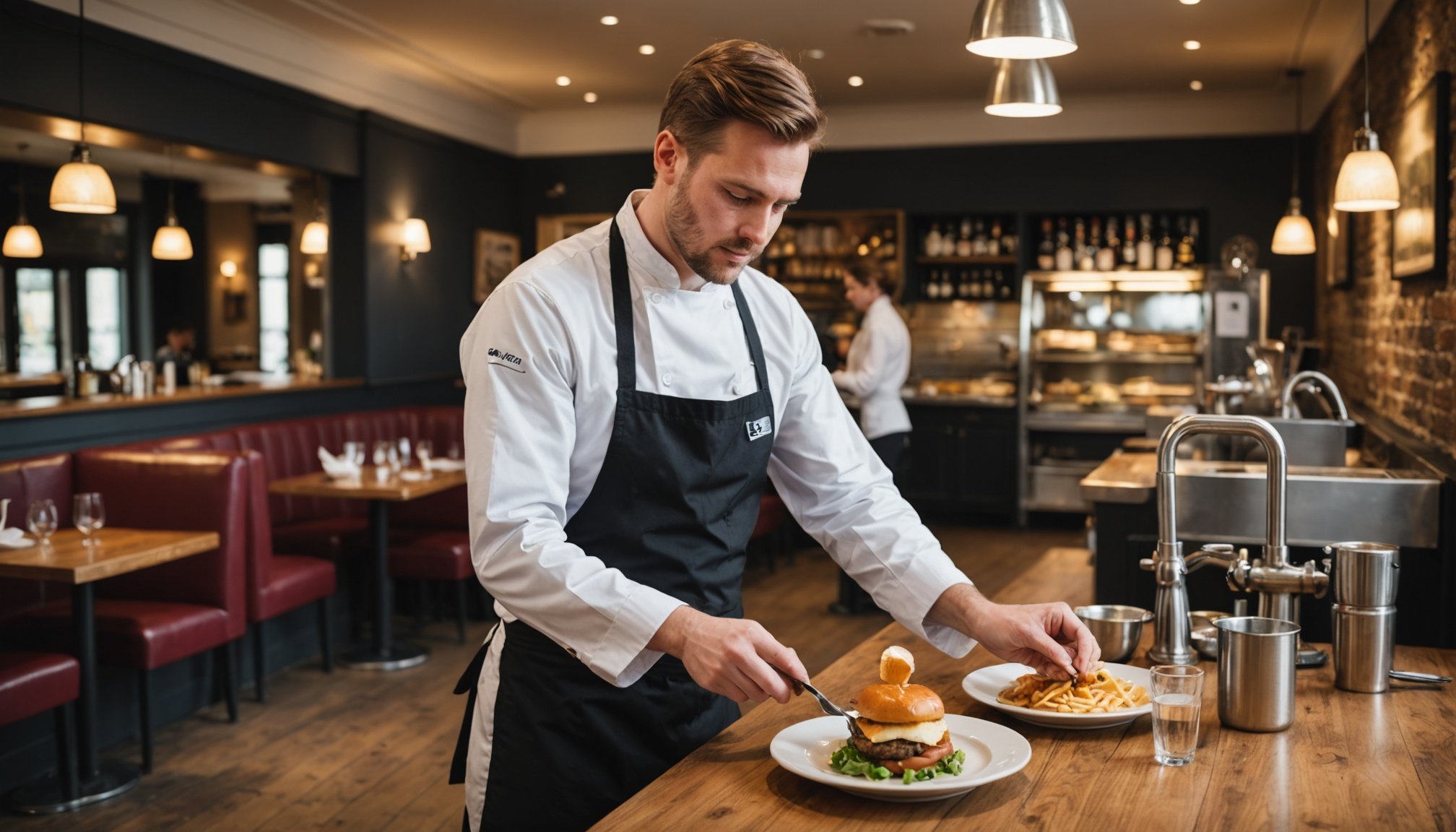Overview of the 2023 Food Hygiene Standards
The latest food hygiene standards introduced in 2023 mark a pivotal shift in how food safety is approached across the UK. These updated standards are designed to safeguard public health while enhancing the operational frameworks within restaurants. The adaptation of these UK restaurant regulations signifies a commitment to enhanced quality control, ensuring consumers receive food that meets stringent safety criteria.
Key Changes in 2023 Regulations
Compared to previous regulations, several significant changes have been implemented. One notable update is the mandatory inclusion of a digital record-keeping system for tracking food sources, preparation methods, and storage conditions. This digital integration aims to streamline the monitoring processes and facilitate quicker responses to potential safety breaches.
A lire en complément : Unlocking the Path: Essential Qualifications to Become a Primary School Teacher in the UK for 2023
Moreover, there is an increased focus on allergen management, mandating more detailed labelling and cross-contamination prevention strategies. Another critical update includes the regular training and certification of food handlers to maintain rigorous hygiene standards.
Understanding these standards’ importance for public health, these regulations strive to minimize foodborne illnesses, boosting consumer confidence in dining establishments. By adhering to these updated protocols, restaurants not only comply with legal requirements but also demonstrate a commitment to excellence in food safety practices. This proactive approach in implementing the 2023 standards will set a new benchmark in the food industry, encouraging a culture of safety and accountability.
Sujet a lire : What are the requirements for UK pet passports post-Brexit in 2023?
Compliance Guidelines for Restaurant Owners
Navigating the landscape of restaurant food safety can be daunting, but understanding the right steps is pivotal for ensuring safe dining experiences. Here, we’ll explore essential compliance tips for meeting contemporary hygiene standards.
Step-by-Step Guide to Meeting New Hygiene Standards
Adhering to the latest hygiene protocols starts with a systematic approach. Begin by conducting a thorough assessment of your current procedures. Identify areas that need alignment with updated guidelines. Next, implement enhanced cleaning protocols, focusing on high-contact surfaces. Ensure that all kitchen equipment is sanitized routinely. It’s crucial to maintain a detailed checklist that aligns with regulatory expectations. Review this list regularly to avoid lapses in compliance.
Essential Resources for Training Staff on Updated Procedures
Training is integral to maintaining high standards. Interactive training modules can be instrumental in educating your team about new hygiene practices. Consider investing in workshops led by food safety experts, offering real-world insights and practical solutions. Utilize online resources, such as webinars and e-learning platforms, to reinforce these practices. Consistent training not only ensures adherence but also empowers staff to recognize potential hazards swiftly.
Common Pitfalls to Avoid
Several stumbling blocks can disrupt your compliance efforts. Avoid neglecting routine audits of your processes—these are vital for identifying inconsistencies. Additionally, ensure that training is not a one-time event; regular refreshers are necessary to sustain knowledge. Avoid disregarding feedback from both staff and patrons, as these insights can be pivotal in refining your approach to food safety. Taking these precautions seriously will fortify your restaurant’s commitment to compliance.
Significance of Food Hygiene in the Restaurant Industry
Ensuring the importance of hygiene in restaurants is paramount, primarily because it safeguards customer safety and mitigates the risk of foodborne illnesses. Poor hygiene practices can lead to contamination and the spread of diseases such as salmonella or E. coli, which can severely impact patrons.
Embedding robust hygiene systems is pivotal for cultivating customer trust. When a restaurant consistently demonstrates its commitment to hygiene, it reassures customers about the safety of its food. This assurance boosts customer loyalty and strengthens the establishment’s reputation. A positive reputation in turn attracts new clientele, as word-of-mouth favors businesses that prioritize customer safety.
Moreover, maintaining high hygiene standards extends significant long-term benefits for business growth. Adherence to strict sanitary practices minimises the likelihood of negative public reports and potential legal action. Such diligence in upholding importance of hygiene can lead to increased operational efficiency and reduced waste due to spoilage. Consequently, this not only helps in retaining existing customers but also enhances the appeal of a restaurant to new customers, facilitating expansion.
In conclusion, good hygiene practices are an invaluable asset that supports a business’s credibility and contributes significantly to its sustainability in a competitive market.
Case Studies: Successful Implementation of New Standards
Several restaurants have showcased exceptional improvements through effective strategies and the adoption of new standards, ultimately contributing to their success. These success stories offer valuable insights into the importance of food hygiene.
Case Study 1: Restaurant A
Restaurant A embarked on a mission to elevate its hygiene practices. By upgrading to advanced sanitation systems and enhancing staff training on cleanliness protocols, the establishment set new benchmarks. As a result, Restaurant A saw a significant reduction in health violations and customer complaints. The measurable outcomes were impressive: a 30% increase in customer satisfaction ratings and a 15% growth in loyal patron visits. Such improvements underscore the importance of prioritising food hygiene in achieving success.
Case Study 2: Restaurant B
Faced with declining revenues due to hygiene issues, Restaurant B underwent a comprehensive transformation. The challenges were numerous, including outdated facilities and scepticism from staff. However, by embracing innovative cleaning technologies and engaging the team actively, they overcame these hurdles. Positive customer feedback boomed, enhancing the restaurant’s reputation, which resulted in a 20% rise in patronage. Restaurant B demonstrated that addressing cleanliness concerns can significantly impact business success.
Case Study 3: Restaurant C
Restaurant C introduced cutting-edge innovations, such as UV disinfection systems, to enhance cleanliness. These efforts not only improved hygiene but also earned them accolades within the industry. The prestigious Clean Restaurant Recognition was awarded due to these upgrades, boosting their brand image and customer confidence. This case exemplifies the direct benefits of implementing innovative solutions tailored towards compliance and hygiene excellence.
Challenges and Solutions in Adapting to New Standards
Adhering to new standards can be daunting for restaurant operators. A common issue is Overcoming Compliance Challenges, which demands understanding and implementing numerous regulations. This is where Solution Strategies become crucial.
Successful establishments navigate these challenges by adopting solution-oriented approaches. They often turn to technology, such as digital compliance tracking tools, which streamline the process of reporting and maintaining standards.
Community and regulatory support play a significant role during this transition. Engaging with local authorities and industry groups can provide valuable guidance. Restaurants benefit from workshops and training sessions that elucidate the intricacies of new regulations. It’s an opportunity for operators to learn together and encourage each other, reinforcing the idea that they’re not alone in their compliance journey. These community endeavours often lead to innovative thinking and shared strategies, reducing the burden on individual businesses and enhancing the understanding of compliance needs.
Moreover, maintaining an open line of communication with regulatory bodies ensures that any queries or potential misunderstandings are swiftly addressed. Establishments that proactively seek support and engage with their local community and regulatory bodies are in a better position to overcome these hurdles efficiently. This approach not only fosters a smoother transition but builds a resilient, compliant operation poised for long-term success.
The Future of Food Hygiene Regulations in the UK
As the landscape of food hygiene regulations continues to evolve, understanding emerging regulatory trends becomes crucial. It’s anticipated that stricter standards in maintaining cleanliness and safety in food premise will be implemented. These regulations might extend to more comprehensive checks on ingredient sources, hygiene certification updates, and enhanced monitoring of allergen management.
For restaurants, keeping abreast of these changes is essential. New regulations can impact operations significantly, requiring adjustments in processes and potential investments in staff training or updated equipment to meet compliance. Restaurant owners must understand that customer expectations will likely expand alongside regulatory changes. Diners are becoming increasingly aware of food safety, emphasising the need for transparency about hygiene practices.
Staying informed about such regulatory trends is essential for maintaining trust and ensuring business continuity in the ever-changing food industry landscape. Tools and seminars focused on upcoming hygiene regulations can assist stakeholders in preparing effectively. Moreover, engaging with regulatory bodies for updates can provide an edge in navigating the future of food hygiene regulations efficiently. Remaining proactive, rather than reactive, is key in adapting to future developments and ensuring the highest standards of food safety and hygiene are met consistently.











